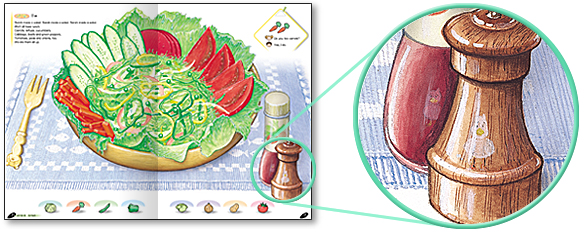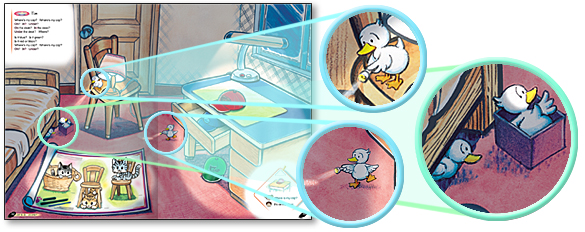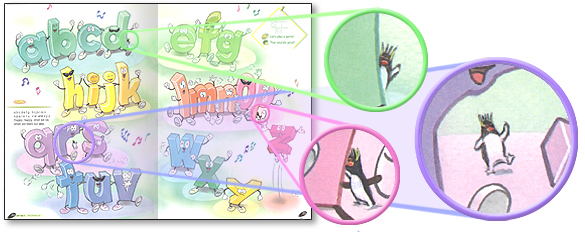

- vol.9 Halloween Activity
- Vol.8 Springboard Series & CD
- Vol. 7 Springboard Series Teaching Guides for ALL 16 Levels!
- Vol. 6 A Picture Dictionary with Appeal to ALL AGES!!
- Vol. 5 Springboard Series and Audio CDs
- Vol. 4 Big Book: Our Sweet Home
- Vol. 3 WELCOME to LW BLUE: Find the Ducks!
- Vol. 2 WELCOME to LW YELLOW: Find the Penguins!
- Vol. 1 Picture Book Workbooks: How to Use Them
Vol. 4 Big Book: Our Sweet Home
All of the 10 picture books in the Picture Books series have a Big Book.
Big Books are great to use for reading aloud with larger classes.
Here are some secrets for Vol.5 Our Sweet Home!
◆spring◆

◆summer◆

◆fall◆

Each page has tiny little creatures. It may look like there is nobody on the page, but if you look very closely, you can find a ladybug, spider, and cricket on the page! Students have to really use their eyes and look carefully to find them. This is great for making students more aware of all the tiny creatures who are living in the parks where they play!

Vol. 3 WELCOME to LW BLUE: Find the Ducks!

WELCOME to Learning World BLUE, which is popular with preschool and lower elementary school students, has ducks hidden throughout!



Throughout the book, there are a total of 56 hidden ducks! Can you find them all?
There are ducks on every 2-page spread of the book.
What kind of English can the students use while looking for the ducks? That is up to the teacher!
These great chances to have fun using English not directly taught in the lesson are important.
Vol. 2 WELCOME to LW YELLOW: Find the Penguins!

WELCOME to Learning World YELLOW is popular with preschool-age children because of its catchy chants and songs. Students often remember them all the way into junior high school! But there are many small details which make the book even more appealing to children. Do you know what they are? When children first discover some of them, they get pretty excited.
Ahh! There’s a penguin here!


In this text, penguins can be found on every 2-page spread. Let’s find the penguins!
But maybe you should not point out the penguins when your first give the students the textbook. Wait until you have done a few units to point it out. Some classes just want to spend the entire class searching for the penguins, and then what happens to your lesson!? Be careful!
◆Special◆ In Unit 4, students sing a color song, but remembering the order of the colors can be hard, right? Well, look at the colors of the balloons… The balloons are grouped according to the order of the colors in the song!
♪Orange,blue, green and pink, brown, yellow, black and red…

At one school in Osaka, students looked and looked at this page. They figured out the order of the balloons all by themselves. Wow!
Vol. 1 Picture Book Workbooks: How to Use Them
The core activities in the Picture Book Workbooks serve different purposes:
- Say the names and words for the characters and items that appear in the picture book
- Use sight reading to figure out how to color certain pictures
- Write the story by tracing the words and sentences in the four ruled lines
Writing out the story in English is also a core reading activity, so this activity is recommended for students who have studied English for at least 2 years, or are in the second grade or higher of elementary school.
With younger students, the teacher could have just one workbook and copy only the coloring pages for the students. Start coloring the pages together in class, but if it is taking too much class time, have the students complete the coloring activity at home.
Introducing pages from one workbook!!

One workbook has 16 pages, including different activities, like connecting items with lines and coloring. Some of the activities are cross-curricular, including some simple math or science.

The full text from the picture book is written out on ruled lines for students to trace!

“Language Learned in this Picture Book”「この絵本でならうこと」is a good page to show to parents.
 The Japanese translation of the story is useful for parents who want to know about the story!
The Japanese translation of the story is useful for parents who want to know about the story!




















